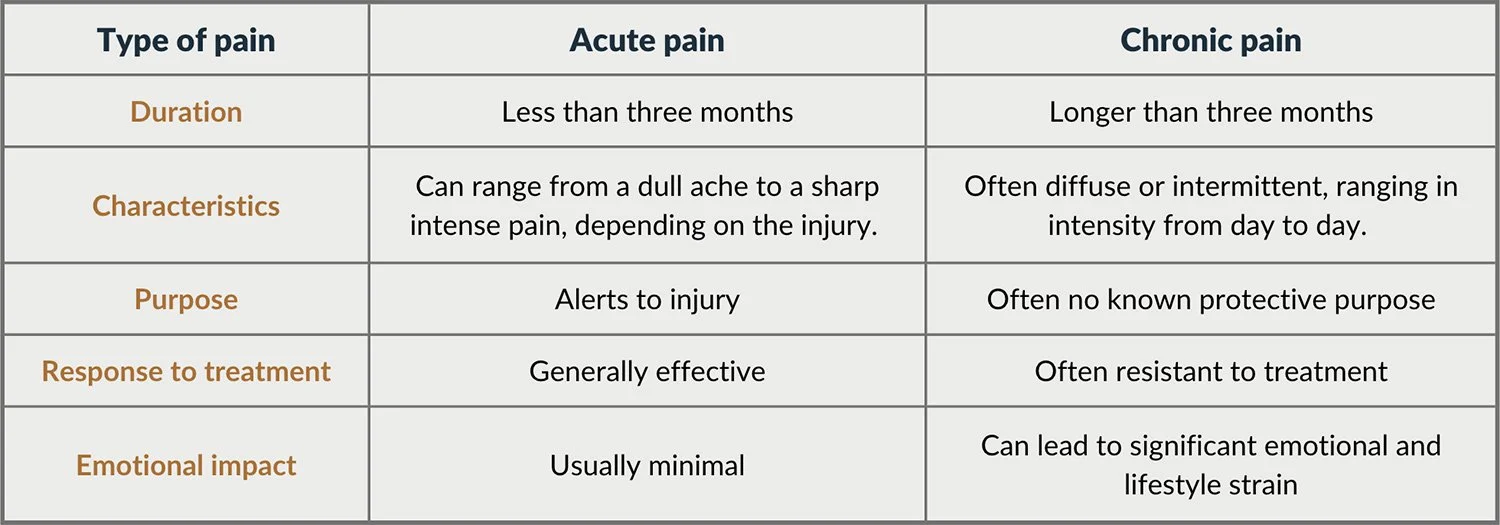Understanding Acute vs Chronic Pain
Which one are you experiencing?
Read time: 5-7 minutes
The most difficult part of getting out of pain is identifying the root problem or cause. Health care professionals often give conflicting opinions. Well-intentioned loved ones often bombard people in pain with uninformed suggestions, which only creates more confusion. Treatment options for joint pain often include: physical therapy, cortisone injections, surgeries, pain or anti-inflammatory medications, nerve blocks, heat, ice, meditation, counseling, rest, lifestyle restrictions, chiropractic, massage, acupuncture, and CBD products. The amount of options and conflicting opinions is confusing and frustrating. It’s no wonder so many people in pain report “feeling stuck”.
You are not stuck in pain. You are lost in pain.
The key challenge when you have joint pain is navigation. Conflicting opinions and symptom chasing treatments leave people wandering in pain for years, never getting to the root cause of their pain problem.
When you’re lost in the wilderness, the first thing you need to do is get perspective. Get high on a mountaintop so you can assess the terrain. The same principle applies to being lost in pain. You must get above your problem and begin to understand it so you can navigate out.
To understand and navigate joint pain with wisdom, there are four key concepts or principles you must understand. The first is understanding the two main types of pain: acute and chronic. These two types of pain are vastly different and need different treatments.
What is acute pain?
Acute joint pain is often the result of tissue injury or post surgical pain. Most of the time, the cause of acute pain is easy enough to pinpoint. Examples of events that cause acute pain include twisting your ankle, straining a muscle, or having surgery.
Acute pain lasts a few days to a couple of weeks. Acute pain often responds well to treatment— over-the-counter medication, rest, physical therapy, or a surgery usually do the trick. The United States’ medical system is highly oriented toward the treatment of acute pain.
What about chronic pain?
Chronic pain is any pain that lasts longer than three months. Examples of chronic pain include low back pain, neck pain, knee pain, hip pain, and foot pain. In some cases there may be “findings” on imaging, but whether or not those findings are generating the pain is often unclear.
Chronic joint pain may begin as acute pain, but once it crosses the three month threshold, it morphs into a different problem altogether. When you are in pain longer than three months, your brain and nerves begin to become sensitized and memorize the pain pattern. Chronic inflammation exacerbates the problem. The decrease in movement, due to the pain, creates lymphatic drainage problems, leaving lingering inflammation in your joints. Joint problems such as decreased range of motion and misalignments cause stress and strain. This creates degenerative conditions in the joints above and below the problem joint, causing even more root causes of pain.
The longer the pain lasts, the more of an impact it has on mental health and lifestyle, leading to issues like anxiety, depression, less human connection, and a heightened drive toward foods containing refined sugar and salt. These issues all worsen the pain and further contribute to the confusion of what’s causing the pain.
Quick comparison: acute vs. chronic pain
Why it matters
Understanding whether pain is acute or chronic is crucial for getting the right treatments. Acute pain management focuses on tackling the immediate issue and helping you heal. In contrast, fixing chronic pain often requires a whole person approach that addresses muscles and joints, inflammation, lifestyle, emotional health, and nervous system problems.
The difference between acute and chronic pain is the first concept to understand in order to navigate joint pain with wisdom. The second concept breaks down the One Problem Illusion of chronic joint pain. That concept is broken down in another blog post, Joint pain is a complex, worsening problem.
Identifying and correcting the underlying root causes of chronic pain is the only way to fix the problem for good. Don’t settle for treatments that temporarily decrease symptoms or fix the root causes. Find and fix the root causes and put your pain problem behind you.
References
National Institutes of Health (NIH). (2020). "Chronic Pain".
American Academy of Pain Medicine. (2021). "Acute vs. Chronic Pain".
Your System Has Been Hijacked: The Neurobiology of Chronic Pain - PMC
Pain and Emotion: A Biopsychosocial Review of Recent Research - PMC
Pain and Depression: A Neurobiological Perspective of Their Relationship
Author Matthew Lister
CEO & Founder of Align



